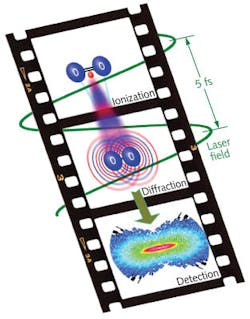ULTRAFAST MOLECULAR IMAGING: LIED technique images ultrafast molecular dynamics

X-ray and electron diffraction techniques can image molecular dynamics and atomic positions on picosecond time scales with sub-Angstrom spatial resolution. However, it is also known that laser-induced electron diffraction (LIED) techniques that self-interrogate a parent molecular structure using laser-ionized bursts of coherent electron wave packets can image molecules with comparable resolution. Using this LIED methodology, researchers at The Ohio State University (Columbus, OH) and Kansas State University (Manhattan, KS) have now demonstrated gas-phase molecular imaging on the femtosecond time scale with unprecedented spatiotemporal resolution.
Laser-induced electron diffraction
The principle of LIED is that an atom, when exposed to an intense ultrashort laser pulse, ionizes and releases an electron (see figure). The laser’s oscillating field can accelerate the electron back to collide with the ionized atom, producing various electron-ion collision processes such as elastic and inelastic scattering and even photorecombination. These “strong field” effects occur on femtosecond time scales, and the electronmomentum distribution can be used to reveal details of molecular interactions. Because pulse energies from a standard Ti:sapphire 800 nm laser can only generate electron-recollision energies of a few tens of electron volts, the researchers turned to a pumped optical parametric amplifier (OPA) configuration to enable recollision energies on the order of 300 eV from mid-infrared (mid-IR) pulses.
The LIED setup uses an 800 nm, 4.4 mJ, 50 fs, 1 kHz Ti:sapphire laser to pump an OPA to generate tunable ultrashort 0.5 mJ, 50 fs linearly polarized mid-IR pulses spanning wavelengths from 1.2 to 2.3 μm. Angle-resolved photoelectron energy (momentum) distributions are then recorded by a time-of-flight spectrometer with multichannel-plate (MCP) detectors as a function of wavelength and at small collection angles limited to ±1º by a small pinhole in front of the detector.
By mapping the momentum distributions of these electrons as a series of images captured at different wavelengths, the nuclear motion of a molecule can be determined as a function of time. For example, LIED analysis showed that the measured N-N bond-length distance for a nitrogen (N2) molecule was practically indistinguishable (based on the 0.05 Å resolution) between the 1.10 Å in the neutral state and 1.12 Å in the ionized state. However, a measurement of the O-O bond length in the oxygen (O2) molecule showed that the distance did change approximately 10 pm (0.1 Å) over a few-femtosecond time scale from the known O-O bond length in the neutral state. This reveals that the oxygen molecule, unlike nitrogen, undergoes a significant structural transformation when a single electron is removed, thus decreasing the bond length in the ion relative to the neutral state.
“The LIED method is just one example of how fundamental science can impact a broader community of scientists,” says Louis DiMauro, Hagenlocker Chair of Physics at The Ohio State University. “The dream would be to use LIED as an ultrafast imaging method for producing molecular movies to understand the dynamics of matter on its natural time scale.”
REFERENCE
1. L. F. DiMauro, “Spatial-temporal Imaging in the Strong-field Limit,” IEEE Photonics Conference 2013, Bellevue, WA, paper MD2.1 (September 9, 2013).

Gail Overton | Senior Editor (2004-2020)
Gail has more than 30 years of engineering, marketing, product management, and editorial experience in the photonics and optical communications industry. Before joining the staff at Laser Focus World in 2004, she held many product management and product marketing roles in the fiber-optics industry, most notably at Hughes (El Segundo, CA), GTE Labs (Waltham, MA), Corning (Corning, NY), Photon Kinetics (Beaverton, OR), and Newport Corporation (Irvine, CA). During her marketing career, Gail published articles in WDM Solutions and Sensors magazine and traveled internationally to conduct product and sales training. Gail received her BS degree in physics, with an emphasis in optics, from San Diego State University in San Diego, CA in May 1986.